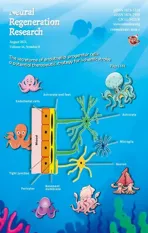目录
- Brain-derived neurotrophic factor and its related enzymes and receptors play important roles after hypoxic-ischemic brain damage
- Environmental enrichment combined with fasudiltreatment inhibits neuronal death in the hippocampal CA1 region and ameliorates memory deficits
- Regulation of neuronal bioenergetics as a therapeutic strategy in neurodegenerative diseases
- The secretome of endothelial progenitor cells:a potential therapeutic strategy for ischemic stroke
- The neuroimaging of neurodegenerative and vascular disease in the secondary prevention of cognitive decline
- Induced pluripotent stem cell technology for spinal cord injury: a promising alternative therapy
- The interaction of stem cells and vascularity in peripheral nerve regeneration
- Cortical plasticity and nerve regeneration after peripheral nerve injury
- The neuroprotective role of Wnt signaling in the retina
- Histone acetylation and deacetylation in ischemic stroke
- Microglia accumulation and activation after subarachnoid hemorrhage
- Potential role of noise to improve intracortical microstimulation in tactile neuroprostheses
- Tips and tricks for cannabinoid receptor 1 detection, interaction and interpretation
- Role of dehydroepiandrosterone sulfate as a scavenging antioxidant: the evidence from Caenorhabditis elegans’nervous system under hypoxia
- CD40L/CD40 bidirectional signaling is a major regulator of neuronal morphology in the developing nervous system
- Klotho and neurons: mutual crosstalk between autophagy,endoplasmic reticulum, and inflammatory response
- Low-dose testosterone replacement therapy and electrically evoked resistance training enhance muscle quality after spinal cord injury
- Stem cell-derived three-dimensional(organoid) models of Alzheimer’s disease: a precision medicine approach
- Mens sana in corpore sano: lifestyle changes modify astrocytes to contain Alzheimer’s disease
- Therapeutic potential of alpha 5 subunit containing GABAA receptors in Alzheimer’s disease
- TLR2 and TLR4-mediated inflammation in Alzheimer’s disease:self-defense or sabotage?
- Application of PROTAC strategy to TTR-Aβ protein-protein interaction for the development of Alzheimer’s disease drugs
- Direct oral anticoagulants: a new therapy against Alzheimer’s disease?
- Non-invasive electrical stimulation as a potential treatment for retinal degenerative diseases
- Targeting transglutaminase 2 as a potential disease modifying therapeutic strategy for synucleinopathies
- Amyloid hypothesis through the lens of Aβ supersaturation
- Therapeutic potential of insulin-like growth factor 2 in Huntington’s disease: controlling proteostasis to alleviate the load of misfolded protein
- Bimanual motor skill learning and robotic assistance for chronic hemiparetic stroke: a randomized controlled trial
- Inhibition of nitric oxide synthase aggravates brain injury in diabetic rats with traumatic brain injury
- P2X7 receptor activation aggravates NADPH oxidase 2-induced oxidative stress after intracerebral hemorrhage
- DDAH2 (-449 G/C) G allele is positively associated with leukoaraiosis in northeastern China: a double-blind,intergroup comparison, case-control study
- ISP and PAP4 peptides promote motor functional recovery after peripheral nerve injury
- Biocompatibility and biosafety of butterfly wings for the clinical use of tissue-engineered nerve grafts
- Gene expression profiles of human adipose-derived mesenchymal stem cells dynamically seeded on clinically available processed nerve allografts and collagen nerve guides
- Changes in proteins related to early nerve repair in a rat model of sciatic nerve injury
- Research trends, hot spots and prospects for necroptosis in the field of neuroscience
- Olfactory ensheathing cell transplantation alters the expression of chondroitin sulfate proteoglycans and promotes axonal regeneration after spinal cord injury
- Therapeutic effects of dental pulp stem cells on vascular dementia in rat models
- Safety and efficacy of a nerve matrix membrane as a collagen nerve wrapping: a randomized, single-blind,multicenter clinical trial
- Glucagon-like peptide-1/glucose-dependent insulinotropic polypeptide dual receptor agonist DACH5 is superior to exendin-4 in protecting neurons in the 6-hydroxydopamine rat Parkinson model
- Peri-infarct reorganization of an injured corticospinal tract in a patient with cerebral infarction
